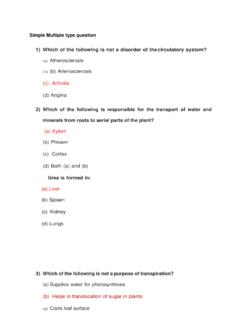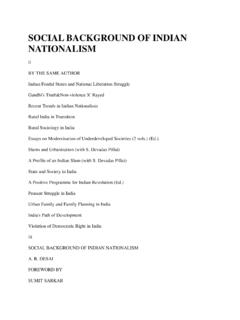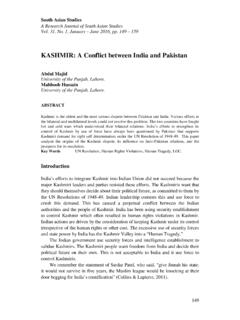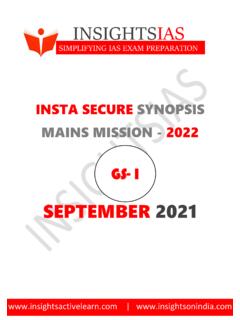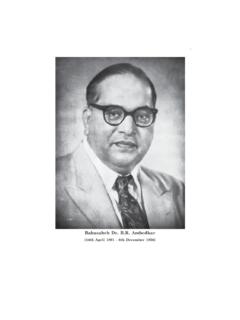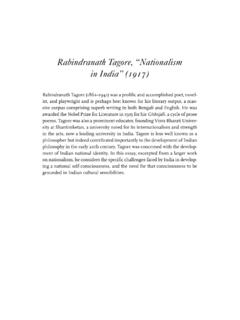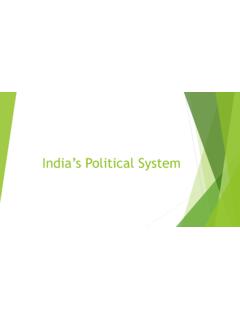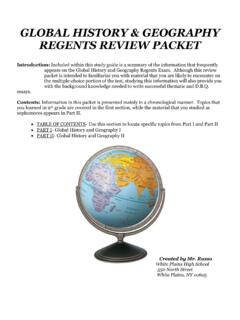Transcription of Class X (2021-22) Term – 1 Syllabus for Board Examinations
1 Class X (2021-22) Term 1 Syllabus for Board Examinations Unit 1: India and the Contemporary World Chapter- 1. The Rise Of nationalism In Europe Unit 2: Contemporary India II Chapters- 1. Resources and Development 3. Water Resources (only map items for Board Examinations ) 4. Agriculture Unit 3: Democratic Politics II Chapters- 1. Power Sharing 2. Federalism Unit 4: Economics Chapters- 1. Development 2. Sectors of the Indian Economy LIST OF MAP ITEMS Class X (2021-22) TERM I GEOGRAPHY (Outline Political Map of India) Chapter 1: Resources and Development (Identification only) Major soil Types Chapter 3: Water Resources (Locating and Labelling) Dams: 1.
2 Salal 2. Bhakra Nangal 3. Tehri 4. Rana Pratap Sagar 5. Sardar Sarovar 6. Hirakud 7. Nagarjuna Sagar 8. Tungabhadra Note: The theoretical aspect of chapter Water Resources to be assessed in the Periodic Tests only and will not be evaluated in Board Examination. However, the map items of this chapter as listed above will be evaluated in Board Examination. Chapter 4: Agriculture (Identification only) a. Major areas of Rice and Wheat b. Largest / Major producer States of Sugarcane, Tea, Coffee, Rubber, Cotton and Jute CONTENT- RISE OF nationalism IN EUROPE MCQ S (including image based and match the followings) Assertion and Reasoning Case Study Based Questions AND DEVELOPMENT MCQ S (including image based, map based and match the followings) Assertion and Reasoning Case Study Based Questions MCQ S (including image based, map based and match the followings) Assertion and Reasoning Case Study Based Questions (MAP) Map Based Questions SHARING MCQ S (including image based and match the followings)
3 Assertion and Reasoning Case Study Based Questions MCQ S (including image based and match the followings) Assertion and Reasoning Case Study Based Questions MCQ S (including image based and match the followings) Assertion and Reasoning Case Study Based Questions SECTORS OF INDIAN ECONOMY MCQ S (including image based and match the followings) Assertion and Reasoning Case Study Based Questions HISTORY CHAPTER- THE RISE OF nationalism IN EUROPE MULTIPLE CHOICE QUESTIONS(MCQ) 1. In the initial stages, the French armies were welcomed as harbingers of liberty. But the initial enthusiasm soon turned to hostility.
4 Identify the reason from the following. taxation, censorship, forced conscription into the French armies uniform laws, standardised weights and measures equality before the law and the right to property administrative divisions, abolished the feudal system 2. Which one of the following statements is not true of Aristocracy? owned estates in the countryside and also town-houses spoke French for purposes of diplomacy and in high society families were often connected by ties of marriage often clashed with the ideas of the monarchs 3. Find out from the following, what economic liberalism stood for.
5 (i)Abolition of state-imposed restrictions on the movement of goods and capital (ii)End of autocracy and clerical privileges (iii)Freedom for the individual and equality of all (iv)Freedom of markets A.(i) and (ii) are correct B.(i) and (iii) are correct C.(ii) and (iv) are correct D.(i) and (iv) are correct 4. ---------------- was the famous English poet, who organised funds and later went to fight in the Greek War of Independence. John Milton Byron Wellington Macaulay 5. ---------------- of 1832 recognised Greece as the independent nation. Treaty of Versailles Congress of Vienna Treaty of Constantinople Treaty of Geneva TERM-1, 2021-22 STUDY SUPPORT MATERIAL- social SCIENCEPage 26.
6 Arrange the following events related to the Formation of Britain as a nation, in chronological order. (i)The Act of Union between England and Scotland (ii)The English parliament, which had seized power from the monarchy (iii)Ireland was forcibly incorporated into the United Kingdom (iv)Catholic revolts against British dominance - i ii iv ii iii iv i ii iii i iv iii 7. Identify the three wars led by Otto van Bismarck that completed the process of German Unification. , Denmark and France , Austria and England , France and England , Austria and Denmark 8.
7 The following characteristics of Marianne were drawn from those of Liberty and of the Republic. red cap, The broken chain, The oak leaves red cap, The tricolour, The cockade broken chain, The tricolour, The cockade oak leaves, The cockade, The tricolour 9. The Balkan area became an area of intense conflict . Find out the reason(s) for conflict. (i)Different Slavic nationalities struggled to define their identity and independence (ii)Each Balkan state hoped to gain more territory at the expense of the others (iii)The Balkans also became the scene of big power rivalry A.
8 (i) and (i) are correct B.(i) and (iii) are correct the above are correct of the above 10. The Nation is most often symbolized in which of the following forms? and Fiction or Images Prints and Songs 11. Which of the following did the European Conservatives not believe in? Institutions of state policy monarchy return to a society of pre-revolutionary days of the Church TERM-1, 2021-22 STUDY SUPPORT MATERIAL- social SCIENCEPage 312. Name the event that mobilised nationalist feelings among the educated elite across Europe. A. Restoration of Bourbon kings to power.
9 B. Greek war of independence. C. The July Revolution. D. Installation of constitutional monarchy with Louis Philippe at its head. 13. Consider these statements about Romanticism, i)Romanticism, was cultural movement. ii)Romanticism was a political movement. Which of the above statement(s) is/are correct? A. i only B. ii only C. Both i and ii D. Neither i nor ii 14. Consider the following. 1. Johann Gottfried - German philosopher 2. uprising in Brussels - Belgium breaking away from the United Kingdom of the Netherlands.
10 3. Delacroix - French Romantic painters. 4. Grimm Brothers - Folktales and Nation-building Which of the above are correctly matched? A. 2 and 3 only B. 1, 2 and 3 only C. 2, 3 and 4 only D. 1, 2, 3 and 4 15. Match the Column I with column II and select the correct answer. A) i - (d) ii - (b) iii - (a) iv - (c) B) i - (a) ii - (b) iii - (c) iv - (d) C) i - (c) ii - (a) iii - (d) iv - (b) D) i - (b) ii - (a) iii - (d) iv - (c) Column IColumn II(i) Victor Emmanuel II(a) Prussia(ii) North German confederation(b) Kingdom of Italy(iii) Giuseppe Mazzini Empire(c) Habsburg and Ottoman(iv) Slav nationalism (d)

